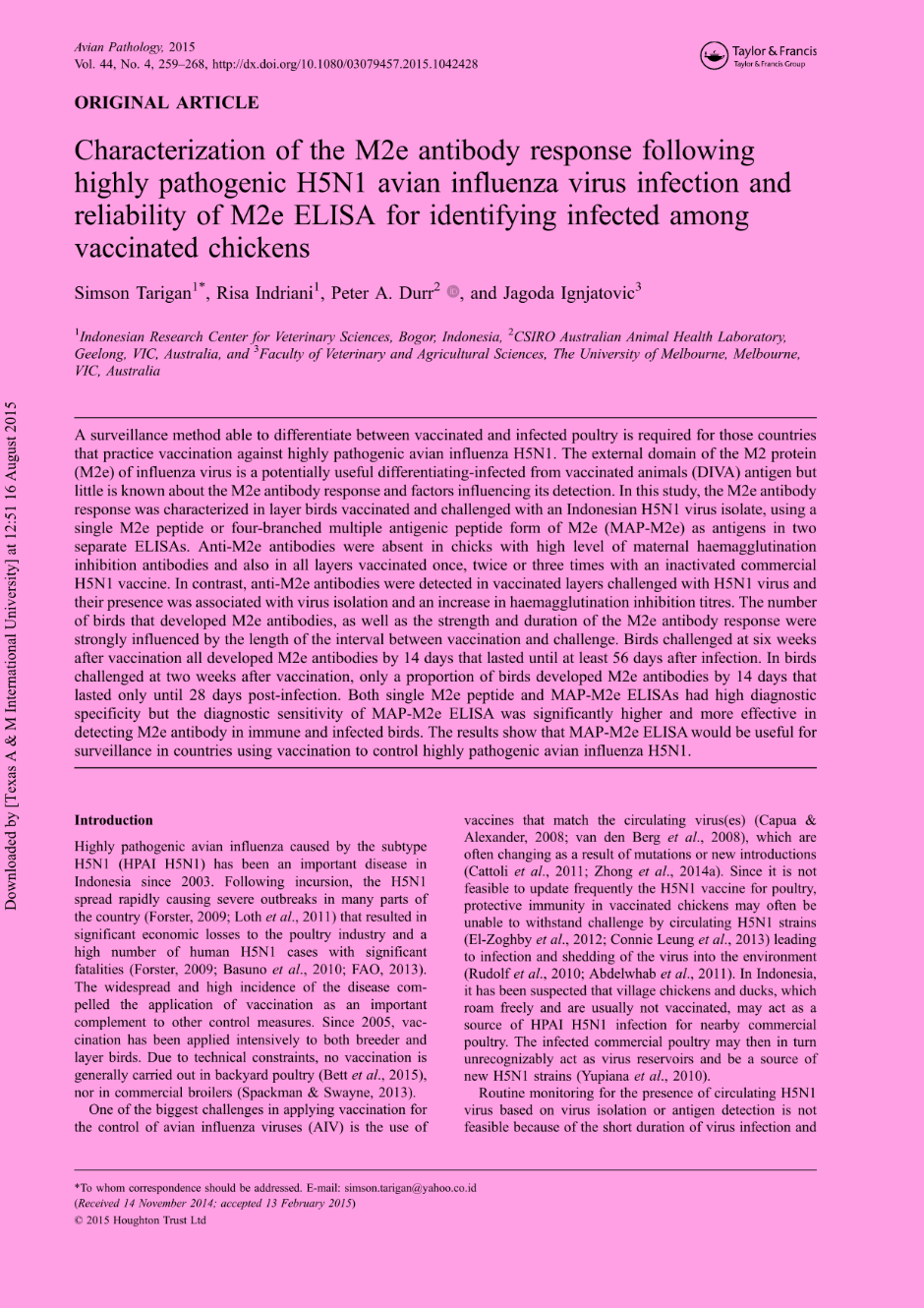
| Judul | Characterization of the M2e antibody response following highly pathogenic H5N1 avian influenza virus infection and reliability of M2e ELISA for identifying infected among vaccinated chickens. / Tarigan, Simson; Indriani, Risa (IRCVS); Durr, Peter A.; Ignjatovic, Jagoada |
| Pengarang | Indriani, Risa (IRCVS) Durr, Peter A. Ignjatovic, Jagoada |
| EDISI | Avian Pathology |
| Penerbitan | 2015 |
| Deskripsi Fisik | Vol. 44 (4), 259–268. |
| Subjek | avian influenza virus |
| Abstrak | A surveillance method able to differentiate between vaccinated and infected poultry is required for those countries that practice vaccination against highly pathogenic avian influenza H5N1. The external domain of the M2 protein (M2e) of influenza virus is a potentially useful differentiating-infected from vaccinated animals (DIVA) antigen but little is known about the M2e antibody response and factors influencing its detection. In this study, the M2e antibody response was characterized in layer birds vaccinated and challenged with an Indonesian H5N1 virus isolate, using a single M2e peptide or four-branched multiple antigenic peptide form of M2e (MAP-M2e) as antigens in two separate ELISAs. Anti-M2e antibodies were absent in chicks with high level of maternal haemagglutination inhibition antibodies and also in all layers vaccinated once, twice or three times with an inactivated commercial H5N1 vaccine. In contrast, anti-M2e antibodies were detected in vaccinated layers challenged with H5N1 virus and |
| Bentuk Karya | Tidak ada kode yang sesuai |
| Target Pembaca | Tidak ada kode yang sesuai |
| No Barcode | No. Panggil | Akses | Lokasi | Ketersediaan |
|---|---|---|---|---|
| ARTVET2077 | ARTVET2077 | Dapat dipinjam | Perpustakaan Balai Besar Pengujian Standar Instrumen Veteriner - Koleksi Agris | Tersedia |
| Tag | Ind1 | Ind2 | Isi |
| 001 | INLIS000000000017804 | ||
| 005 | 20210804032621 | ||
| 008 | 210804################|##########|#|## | ||
| 035 | # | # | $a 0010-0721002336 |
| 082 | # | # | $a ARTVET2077 |
| 084 | # | # | $a ARTVET2077 |
| 245 | # | # | $a Characterization of the M2e antibody response following highly pathogenic H5N1 avian influenza virus infection and reliability of M2e ELISA for identifying infected among vaccinated chickens. /$c Tarigan, Simson; Indriani, Risa (IRCVS); Durr, Peter A.; Ignjatovic, Jagoada |
| 250 | # | # | $a Avian Pathology |
| 260 | # | # | ,$c 2015 |
| 300 | # | # | $a Vol. 44 (4), 259–268. |
| 520 | # | # | $a A surveillance method able to differentiate between vaccinated and infected poultry is required for those countries that practice vaccination against highly pathogenic avian influenza H5N1. The external domain of the M2 protein (M2e) of influenza virus is a potentially useful differentiating-infected from vaccinated animals (DIVA) antigen but little is known about the M2e antibody response and factors influencing its detection. In this study, the M2e antibody response was characterized in layer birds vaccinated and challenged with an Indonesian H5N1 virus isolate, using a single M2e peptide or four-branched multiple antigenic peptide form of M2e (MAP-M2e) as antigens in two separate ELISAs. Anti-M2e antibodies were absent in chicks with high level of maternal haemagglutination inhibition antibodies and also in all layers vaccinated once, twice or three times with an inactivated commercial H5N1 vaccine. In contrast, anti-M2e antibodies were detected in vaccinated layers challenged with H5N1 virus and their presence was associated with virus isolation and an increase in haemagglutination inhibition titres. The number of birds that developed M2e antibodies, as well as the strength and duration of the M2e antibody response were strongly influenced by the length of the interval between vaccination and challenge. Birds challenged at six weeks after vaccination all developed M2e antibodies by 14 days that lasted until at least 56 days after infection. In birds challenged at two weeks after vaccination, only a proportion of birds developed M2e antibodies by 14 days that lasted only until 28 days post-infection. Both single M2e peptide and MAP-M2e ELISAs had high diagnostic specificity but the diagnostic sensitivity of MAP-M2e ELISA was significantly higher and more effective in detecting M2e antibody in immune and infected birds. The results show that MAP-M2e ELISA would be useful for surveillance in countries using vaccination to control highly pathogenic avian influenza H5N1. |
| 650 | # | 4 | $a avian influenza virus |
| 700 | # | $a Durr, Peter A. | |
| 700 | # | $a Ignjatovic, Jagoada | |
| 700 | # | $a Indriani, Risa (IRCVS) | |
| 990 | # | # | $a ARTVET2077 |
| No | Nama File | Nama File Format Flash | Format File | Action |
| 1 | ARTVET2077.pdf | ARTVET2077 | Baca Online |
Content Unduh katalog
Karya Terkait :